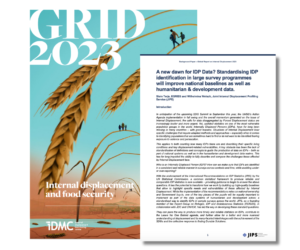 This background paper, written by Stein Terje, EGRISS and Statistical Expert and Wilhelmina Welsch JIPS Coordinator, is JIPS’ contribution to the 2023 Global Report on Internal Displacement, issued each year by the Internal Displacement Monitoring Centre (IDMC).
This background paper, written by Stein Terje, EGRISS and Statistical Expert and Wilhelmina Welsch JIPS Coordinator, is JIPS’ contribution to the 2023 Global Report on Internal Displacement, issued each year by the Internal Displacement Monitoring Centre (IDMC).
Updated statistics on one of the most vulnerable population groups in the world, Internally Displaced Persons (IDPs), have for long been missing in many countries – with good reasons. Situations of Internal Displacement bear specific challenges that require adapted methods and approaches – especially when it comes to identifying populations that are sometimes hard to find or do not want to be identified fearing exposure to violence and persecution.
This applies to both counting how many IDPs there are and describing their specific living conditions and key displacement–related vulnerabilities. A key obstacle has been the lack of standardisation of definitions and concepts to guide the production of data on IDPs – both as part of national systems as well as in the humanitarian and development data realms. This has for long impeded the ability to fully describe and compare the challenges those affected by Internal Displacement face.
With the endorsement of the International Recommendations on IDP Statistics (IRIS) by the UN Statistical Commission, a common statistical framework to produce reliable and comparable IDP statistics is now available. This paper outlines efforts by JIPS, as a founding member of the Expert Group on Refugee, IDP and Statelessness Statistics (EGRISS), in collaboration with JDC and UNHCR, to develop another key piece of the puzzle to make IDPs visible: a standardised way to identify IDPs in sample surveys across the world. This can pave the way to produce more timely and reliable statistics on IDPs, contribute to the Leave No One Behind agenda, and further allow for a better and more nuanced understanding of displacement and its many–faceted interlinkages with the achievement of the SDGs and the collective response to finding Durable Solutions.
Key messages from the background paper: